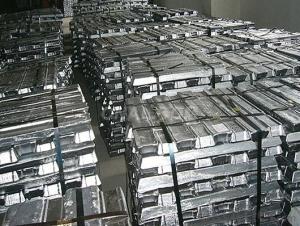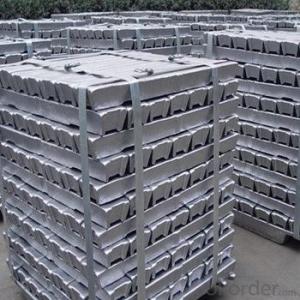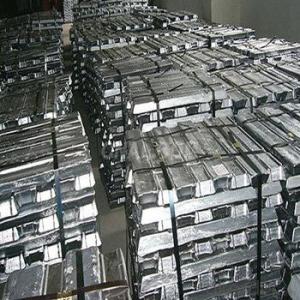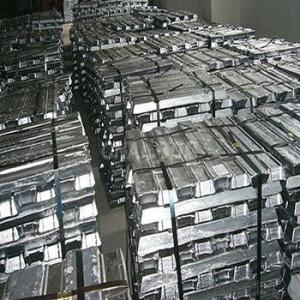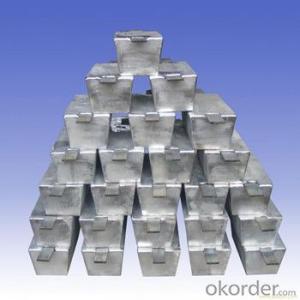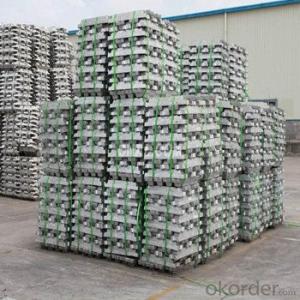Aluminium Ingots With Hgih Quality 99.7%
- Loading Port:
- China main port
- Payment Terms:
- TT OR LC
- Min Order Qty:
- 1000 m.t
- Supply Capability:
- 10000 m.t/month
OKorder Service Pledge
OKorder Financial Service
You Might Also Like
Pure Aluminum Ingot Used for Industry
1.Structure of Aluminum Ingot Description
An ingot is a piece of material, usually metal, that is cast into a shape suitable for further processing. Insteelmaking, it is the first step among semi-finished casting products. Ingots usually require a second procedure of shaping, such as cold/hot working, cutting, or milling to produce a useful final product. Non-metallic and semiconductor materials prepared in bulk form may also be referred to as ingots, particularly when cast by mold based methods.
2.Main Features of the Aluminum Ingot
•High Purity
•High strength
•Fast melting
•Best price
•Good after-service
3. Aluminum Ingot Images
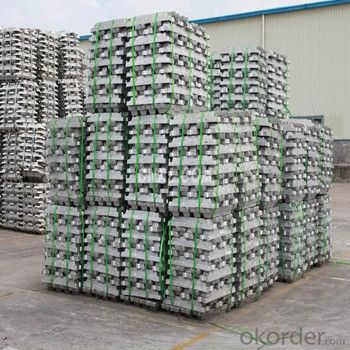
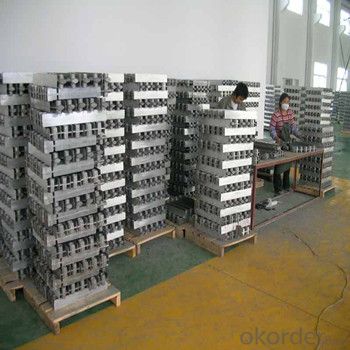
4. Aluminum Ingot Specification
Grade | Chemical Composition % | |||||||||
Al≥ | impurities ≤ | |||||||||
Si | Fe | Cu | Ga | Mg | Zn | Mn | others | Sum | ||
Al99.9 | 99.90 | 0.50 | 0.07 | 0.005 | 0.02 | 0.01 | 0.025 | - | 0.010 | 0.10 |
Al99.85 | 99.85 | 0.80 | 0.12 | 0.005 | 0.03 | 0.02 | 0.030 | - | 0.015 | 0.15 |
Al99.7 | 99.70 | 0.10 | 0.20 | 0.010 | 0.03 | 0.02 | 0.030 | - | 0.030 | 0.30 |
Al99.6 | 99.60 | 0.16 | 0.25 | 0.010 | 0.03 | 0.03 | 0.030 | - | 0.030 | 0.40 |
Al99.5 | 99.50 | 0.22 | 0.30 | 0.020 | 0.03 | 0.05 | 0.050 | - | 0.030 | 0.50 |
Al99.00 | 99.00 | 0.42 | 0.50 | 0.020 | 0.03 | 0.05 | 0.050 | - | 0.050 | 1.00 |
5.FAQ of Aluminum Ingot
We have organized several common questions for our clients,may help you sincerely:
①How about your company?
A world class manufacturer & supplier of castings forging in carbon steel and alloy steel,is one of the large-scale professional investment casting production bases in China,consisting of both casting foundry forging and machining factory. Annually more than 8000 tons Precision casting and forging parts are exported to markets in Europe,America and Japan. OEM casting and forging service available according to customer’s requirements.
②How to guarantee the quality of the products?
We have established the international advanced quality management system,every link from raw material to final product we have strict quality test;We resolutely put an end to unqualified products flowing into the market. At the same time, we will provide necessary follow-up service assurance.
③How long can we receive the product after purchase?
In the purchase of product within three working days, We will arrange the factory delivery as soon as possible. The pecific time of receiving is related to the state and position of customers.Commonly 7 to 10 working days can be served.
- Q:What are the different extrusion processes for aluminum ingots?
- There are several different extrusion processes for aluminum ingots, each with its own unique characteristics and applications. Some of the most commonly used extrusion processes for aluminum include: 1. Direct extrusion: This is the most common extrusion process for aluminum ingots. In this process, the ingot is heated and then forced through a die using a ram or a hydraulic press. The material flows in the same direction as the ram, resulting in a continuous profile with a consistent cross-section. 2. Indirect extrusion: In this process, the die is stationary and the ingot is forced through the die using a hollow ram. The material flows in the opposite direction of the ram, resulting in a profile with a higher surface finish and improved mechanical properties. 3. Impact extrusion: This process is used to create hollow shapes, such as tubes or containers, by striking a punch against the ingot. The force of the impact causes the metal to flow around the punch, forming the desired shape. Impact extrusion is often used for high-volume production of small parts. 4. Cold extrusion: Unlike the previous processes which involve heating the ingot, cold extrusion is performed at room temperature. The ingot is placed in a die and compressed using a hydraulic press or mechanical force. Cold extrusion is commonly used for producing complex shapes with tight tolerances and excellent surface finish. 5. Hydrostatic extrusion: This process involves placing the ingot in a sealed chamber filled with a liquid, typically oil or water. Pressure is applied to the liquid, which in turn applies even pressure on the ingot. Hydrostatic extrusion is often used for extruding alloys with low ductility or complex shapes. Each extrusion process has its advantages and limitations, and the choice depends on factors such as the desired product shape, material properties, production volume, and cost considerations.
- Q:What are the advantages of using aluminum ingots in the production of electrical transmission lines?
- Using aluminum ingots in the production of electrical transmission lines offers several benefits. Firstly, aluminum, being a lightweight metal, is easier to transport and install compared to materials like copper, reducing overall costs and effort involved in construction and maintenance. Secondly, aluminum possesses excellent conductivity properties, enabling efficient transmission of electricity. This results in less energy loss during transmission, increasing efficiency and minimizing power wastage. Furthermore, aluminum exhibits high resistance to corrosion, making it ideal for outdoor applications. It can withstand harsh weather conditions and environmental factors, ensuring the longevity and reliability of transmission lines. Additionally, aluminum is a cost-effective option due to its abundance and relatively low extraction cost. This affordability makes it a suitable choice for large-scale transmission line projects. Moreover, aluminum is highly recyclable, making it environmentally friendly. The recycling process requires significantly less energy compared to the production of virgin aluminum, reducing carbon emissions and energy consumption. Lastly, aluminum ingots can be easily shaped into various forms, allowing for flexibility in transmission line design and construction. This adaptability ensures optimal functionality in different terrains and installation requirements. In conclusion, the advantages of using aluminum ingots in electrical transmission line production include lightweight construction, high conductivity, corrosion resistance, cost-effectiveness, recyclability, and design flexibility. These benefits make aluminum a preferred choice for efficient and sustainable electricity transmission.
- Q:What are the limitations of using aluminum ingots in high-temperature applications?
- There are several limitations associated with using aluminum ingots in high-temperature applications. Firstly, aluminum has a relatively low melting point of around 660 degrees Celsius. This means that it may not be able to withstand extremely high temperatures typically encountered in some industrial processes or aerospace applications. At such elevated temperatures, aluminum tends to soften and lose its mechanical strength, which can compromise the integrity and functionality of the component or structure. Secondly, aluminum has a high coefficient of thermal expansion. This means that it expands significantly when exposed to heat. This expansion can lead to dimensional instability and can cause issues such as warping or distortion of the component, especially when subjected to rapid or uneven heating and cooling cycles. These dimensional changes can affect the accuracy of the final product and may require additional measures to compensate for the thermal expansion. Additionally, aluminum has relatively poor resistance to oxidation at high temperatures. When exposed to oxygen at elevated temperatures, aluminum can form a thin layer of aluminum oxide, which can act as a barrier and protect the underlying metal from further oxidation. However, at extremely high temperatures, this protective layer can break down, leading to increased susceptibility to oxidation and corrosion. This can result in a reduction in the strength and durability of the aluminum component. Lastly, aluminum has a relatively low strength compared to other materials such as steel or titanium. While aluminum alloys can be developed to enhance their strength, they still may not be suitable for applications requiring exceptional strength at high temperatures. In situations where high mechanical strength is crucial, alternative materials with better high-temperature strength properties may be more suitable. In summary, the limitations of using aluminum ingots in high-temperature applications include its low melting point, high coefficient of thermal expansion, susceptibility to oxidation, and relatively low strength. These factors need to be carefully considered when selecting materials for high-temperature applications to ensure the desired performance and reliability of the components or structures.
- Q:What is the purity level of aluminum in an ingot?
- The purity level of aluminum in an ingot can vary depending on the specific manufacturing process and desired application. However, commonly produced aluminum ingots have a purity level of around 99.5% to 99.9%, which means they contain very minimal impurities.
- Q:How are aluminum ingots melted?
- The typical method for melting aluminum ingots involves a process known as smelting. Smelting is when a metal is extracted from its ore by heating it to a high temperature, causing the metal to melt and separate from impurities. To accomplish the melting of aluminum ingots, a specially designed furnace is employed. This furnace is able to withstand the necessary high temperatures. The ingots are placed into the furnace and heated to temperatures ranging from 660°C to 780°C (1220°F to 1436°F). The furnace is usually fueled by natural gas, oil, or electricity. Once the ingots reach the desired temperature, they begin to melt and transition into a liquid state. At this stage, any impurities or foreign materials within the ingots separate and float to the top, forming a layer referred to as dross. The dross is then eliminated from the surface of the molten aluminum using various methods, such as skimming or specialized tools. After the removal of the dross, the molten aluminum is prepared for further processing or molding into different shapes. It can be poured into molds to create various products or refined further to meet specific requirements. The molten aluminum can also be combined with other metals to enhance its properties or mixed with additives to improve its strength, durability, or other desired characteristics. In summary, the process of melting aluminum ingots involves subjecting them to high temperatures in a furnace, causing them to melt into a liquid form, eliminating any impurities, and then carrying out additional processing or molding of the molten aluminum as necessary.
- Q:How does the ADC12 die casting aluminium ingot contain copper?
- If the amount of Cu is not too high, you can try to buy some A00 aluminum ingots to reduce the content of Cu, but after adding A00 aluminum, other chemicals will also be reduced, but as long as the main ingredients in the range, there will be no problem
- Q:How are aluminum ingots used in the production of cookware?
- Aluminum ingots play a crucial role in the production of cookware due to their unique properties. These ingots are melted down and then shaped into desired cookware forms, such as pots, pans, and baking sheets. One of the main reasons aluminum is widely used in cookware production is its excellent heat conductivity. Aluminum conducts heat more efficiently than other metals, which ensures even heat distribution across the entire surface of the cookware. This property allows for consistent cooking results, preventing hotspots and reducing the risk of food burning or sticking to the pan. Moreover, aluminum is lightweight and easy to handle, making it a popular choice for cookware. This feature is particularly beneficial for individuals with limited strength or mobility, as it enables them to maneuver and lift the cookware without much effort. However, pure aluminum is relatively soft and susceptible to scratches and dents. To improve its durability, aluminum ingots are often alloyed with other metals, such as copper or stainless steel, during the cookware manufacturing process. These alloys enhance the strength and hardness of the cookware while retaining the excellent heat conductivity of aluminum. Additionally, aluminum is non-reactive, meaning it does not interact with acidic or alkaline foods. This characteristic ensures that the taste and quality of the cooked food are not affected by the cookware material. Furthermore, aluminum cookware is generally affordable, making it accessible to a wide range of consumers. Its cost-effectiveness, combined with its excellent cooking performance, has made aluminum cookware a staple in many kitchens around the world. In conclusion, aluminum ingots are indispensable in the production of cookware due to their excellent heat conductivity, lightweight nature, and non-reactive properties. By utilizing aluminum ingots, manufacturers can create cookware that provides even heat distribution, durability, and affordability to enhance the cooking experience for consumers.
- Q:What is the difference between a aluminium ingot with and without a ticket?
- Beijing's purchase price is the price of aluminum, aluminum ingot + processing fees, billing is generally not a ton of processing fee will be about 400 yuan less, your price is overall, the overall profits can be, I think do not have to manage open ballot problem of aluminum ingots.
- Q:Can aluminum ingots be anodized?
- Yes, aluminum ingots can be anodized. Anodizing is a process that involves creating an oxide layer on the surface of aluminum, which can be done on both raw aluminum and aluminum alloys. This process enhances the metal's corrosion resistance, improves its appearance, and allows for coloring or dyeing options.
- Q:What is the weight of a standard aluminum ingot?
- The weight of a standard aluminum ingot can vary depending on its size and dimensions. However, a common standard for aluminum ingots is around 22.5 kilograms or 50 pounds.
1. Manufacturer Overview |
|
|---|---|
| Location | |
| Year Established | |
| Annual Output Value | |
| Main Markets | |
| Company Certifications | |
2. Manufacturer Certificates |
|
|---|---|
| a) Certification Name | |
| Range | |
| Reference | |
| Validity Period | |
3. Manufacturer Capability |
|
|---|---|
| a)Trade Capacity | |
| Nearest Port | |
| Export Percentage | |
| No.of Employees in Trade Department | |
| Language Spoken: | |
| b)Factory Information | |
| Factory Size: | |
| No. of Production Lines | |
| Contract Manufacturing | |
| Product Price Range | |
Send your message to us
Aluminium Ingots With Hgih Quality 99.7%
- Loading Port:
- China main port
- Payment Terms:
- TT OR LC
- Min Order Qty:
- 1000 m.t
- Supply Capability:
- 10000 m.t/month
OKorder Service Pledge
OKorder Financial Service
Similar products
New products
Hot products
Related keywords
